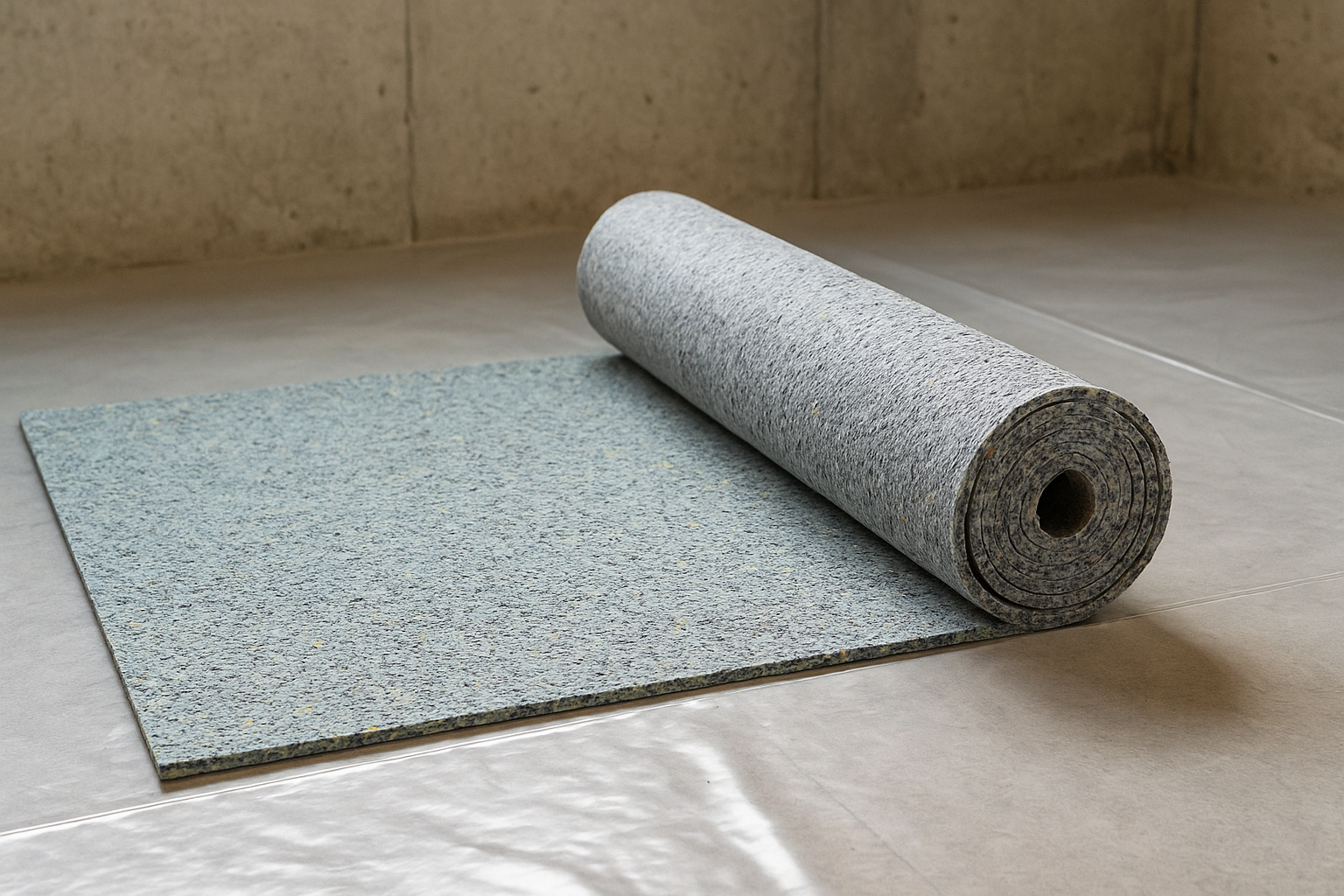Basements are unique: cool slabs, variable humidity, and the ever-present risk of moisture. The right carpet pad makes the space feel warmer and quieter—and protects the carpet from premature wear. Below, we break down the best carpet padding for basements, the right thickness and density, how to handle vapor barriers, and what to avoid so your floor stays comfortable and trouble-free.
Quick Answer
- Best overall: Frothed foam pad (10–12 lb density, ~7–10 mm / 5/16–3/8 in) over a properly installed 6–10 mil vapor barrier on the slab.
- Best budget: Rebond pad at 8 lb density (max 3/8 in thick) with a separate vapor barrier.
- Avoid: Overly thick pads (> 7/16 in), low-density rebond (≤ 5 lb), “memory foam” style pads, or relying on “film-backed” pads without a dedicated vapor barrier.
Basement Priorities: What Matters Most
- Moisture management: Slabs can transmit vapor. Use a continuous polyethylene vapor barrier (6–10 mil) with taped seams directly on the concrete before padding.
- Density first, not just thickness: Higher density resists compression, keeps carpet from matting, and feels solid underfoot.
- Thermal comfort & acoustics: Pads add warmth and lower echo—key benefits in below-grade spaces.
Best Basement Carpet Padding Types (Pros/Cons)
| Pad Type | Basement Suitability | Typical Density | Typical Thickness | Pros | Cons |
|---|---|---|---|---|---|
| Frothed Foam | Excellent | 10–12 lb | 5/16–3/8 in | High resilience, great support, stable in humidity | Higher cost |
| Rebond (urethane) | Good (with vapor barrier) | 8 lb (min) | 5/16–3/8 in | Affordable, widely available | Lower grades (≤5 lb) compress; avoid too thick |
| Rubber (flat) | Good | 18–22 lb (equivalent) | 1/4–3/8 in | Durable, dense, excellent support | Pricey; check compatibility with carpet warranty |
| Fiber/Felt | Fair | Varies (oz/yd²) | 1/4–3/8 in | Stable, breathable | Less cushion; watch moisture and quality |
Recommended Specs for Basements
- Thickness: Aim for 5/16–3/8 inch (8–10 mm). Thicker pads can cause carpet instability and seam issues in basements.
- Density: Minimum 8 lb rebond, or 10–12 lb frothed foam for better longevity and support.
- Antimicrobial: Prefer pads with antimicrobial treatment as a safeguard.
- R-Value: More is warmer, but don’t chase thickness at the expense of stability—pair moderate pad thickness with an area rug if you want extra warmth.
Vapor Barrier vs. “Moisture” Pads
A film-backed or “moisture resistant” pad is not a substitute for a dedicated vapor barrier. In basements, do the stack this way:
- Concrete slab → polyethylene vapor barrier (6–10 mil), seams overlapped & taped, run up the perimeter a few inches
- Carpet pad (frothed foam 10–12 lb or rebond 8 lb)
- Carpet (appropriate for below-grade)
Why? The vapor barrier blocks ground moisture before it reaches the pad. A film on the pad may trap moisture within the pad layer; the separate barrier is more reliable and easier to inspect/repair.
What to Avoid in a Basement
- Overly thick pads (> 7/16 in): can cause carpet movement, seam peaking, and premature wear.
- Low-density rebond (≤ 5 lb): compresses quickly and telegraphs wear patterns.
- “Memory foam” style pads: plush at first but can bottom out, trap moisture, and void some warranties.
- No vapor barrier: relying on pad alone invites odor, mildew, and backing damage over time.
Prep & Installation Checklist
- Fix bulk water first: Address leaks, foundation cracks, or sump/pump issues before any flooring work.
- Dry the space: Run a dehumidifier and keep relative humidity roughly 30–50%.
- Test the slab: Ensure the concrete is dry to the touch and stable (installer may use a moisture meter as part of best practice).
- Install the barrier correctly: 6–10 mil poly, flat, wrinkle-free, seams taped, perimeter turned up (trimmed behind tack strip as needed).
- Professional stretch: Proper power-stretching reduces ripples and extends carpet life.
Best Pairings (Carpet Type + Pad)
- Loop/Berber carpets: Pad 1/4–5/16 in, high density (10–12 lb foam or 8 lb rebond) to limit flex and protect loops.
- Cut pile/Plush: Pad 5/16–3/8 in, 8–12 lb density depending on desired feel and traffic.
- Stairs & halls: Consider thinner/higher-density for better stair definition and durability.
Related Guides
FAQ
Do I need a vapor barrier if I’ve never seen water in my basement?
Yes. Concrete can pass vapor even without visible water. A simple polyethylene barrier prevents that moisture from reaching the pad and carpet backing.
What pad thickness is ideal for basements?
Stick to 5/16–3/8 inch. Thicker pads can cause instability and shorten carpet life in below-grade spaces.
Is rubber pad good in a basement?
Flat rubber is dense and durable, but confirm compatibility with your carpet’s warranty and still use a separate vapor barrier on the slab.
Will antimicrobial padding stop mold?
It’s a safeguard, not a cure. The real protection is controlling moisture with a proper vapor barrier and keeping humidity in check.
